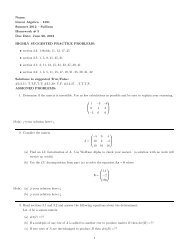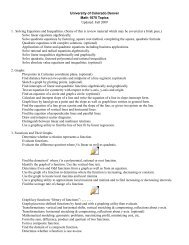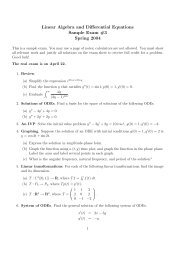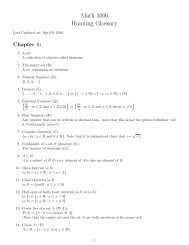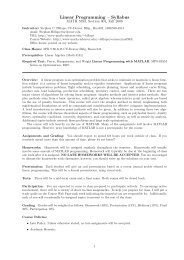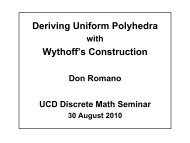A Game-Theoretic Approach to Personnel Decisions in American ...
A Game-Theoretic Approach to Personnel Decisions in American ...
A Game-Theoretic Approach to Personnel Decisions in American ...
Create successful ePaper yourself
Turn your PDF publications into a flip-book with our unique Google optimized e-Paper software.
Thus, the break<strong>in</strong>g po<strong>in</strong>t is a function of δ and the <strong>in</strong>itial payoffs. As one<br />
would expect, the offense and defense converge <strong>to</strong> a pure strategy at the break<strong>in</strong>g<br />
po<strong>in</strong>t, as evidenced by the fact that Pdef(δ, (ar,p−ap,p) (ar,p−ap,p)<br />
) = P(δ, ) =<br />
(ap,p−δar,p) (ap,p−δar,p)<br />
1. To account for the defensive change from a mixed strategy <strong>to</strong> a pure strategy<br />
at the break<strong>in</strong>g po<strong>in</strong>t, we give the follow<strong>in</strong>g discont<strong>in</strong>uous Nash equilibrium<br />
runn<strong>in</strong>g function when x ≥ 0.<br />
R ∗ ⎧ (ap,r−ap,p)(1+x)<br />
⎨ D<br />
(δ,x) =<br />
⎩<br />
0 otherwise.<br />
0 ≤ x < (ar,p−ap,p)<br />
(ap,p−ar,pδ) ,<br />
Similarly, we def<strong>in</strong>e the discont<strong>in</strong>uous Nash equilibrium pass<strong>in</strong>g function<br />
<strong>to</strong> be P ∗ (δ,x) = 1 − R ∗ (δ,x). The runn<strong>in</strong>g function R ∗ encompasses the<br />
above discussion that there is a mixed strategy solution prior <strong>to</strong> the break<strong>in</strong>g<br />
po<strong>in</strong>t, and that after the break<strong>in</strong>g po<strong>in</strong>t has been reached, quarterback play<br />
has become so <strong>in</strong>fluential that the offense only passes.<br />
Next, we calculate V , the value of the game expressed <strong>in</strong> Table 2. If x<br />
is past the break<strong>in</strong>g po<strong>in</strong>t, then V = ap,p(1 + x), as both teams pursue a pure<br />
strategy. Otherwise, we simply evaluate either side of Equation (1) at R(δ,x).<br />
After simplify<strong>in</strong>g, we obta<strong>in</strong> the follow<strong>in</strong>g expression for the value of the game<br />
V (δ,x) = (1 + δx)(1 + x)(ar,pap,r − ap,par,r)<br />
. (6)<br />
D<br />
Observe that (ar,pap,r − ap,par,r) = 0 s<strong>in</strong>ce the payoff matrix A has no<br />
dom<strong>in</strong>ant rows or columns, and hence its rows and columns are necessarily<br />
l<strong>in</strong>early <strong>in</strong>dependent. S<strong>in</strong>ce V depends on the nature of the game, it is likely a<br />
discont<strong>in</strong>uous function of x at the break<strong>in</strong>g po<strong>in</strong>t. Under our assumption that<br />
ap,r > ap,p we obta<strong>in</strong> the follow<strong>in</strong>g expression for the value of the game when<br />
x ≥ 0.<br />
V ∗ ⎧ (1+δx)(1+x)(ar,pap,r−ap,par,r)<br />
⎨<br />
D<br />
(δ,x) =<br />
⎩<br />
ap,p(1 + x) otherwise.<br />
0 ≤ x < (ar,p−ap,p)<br />
(ap,p−δar,p) ,<br />
Before we proceed with our predictive example, we exam<strong>in</strong>e an <strong>in</strong>terest<strong>in</strong>g<br />
and unexpected property of R ∗ . For values of x less than the break<strong>in</strong>g<br />
po<strong>in</strong>t, we observe that<br />
(5)<br />
(7)







